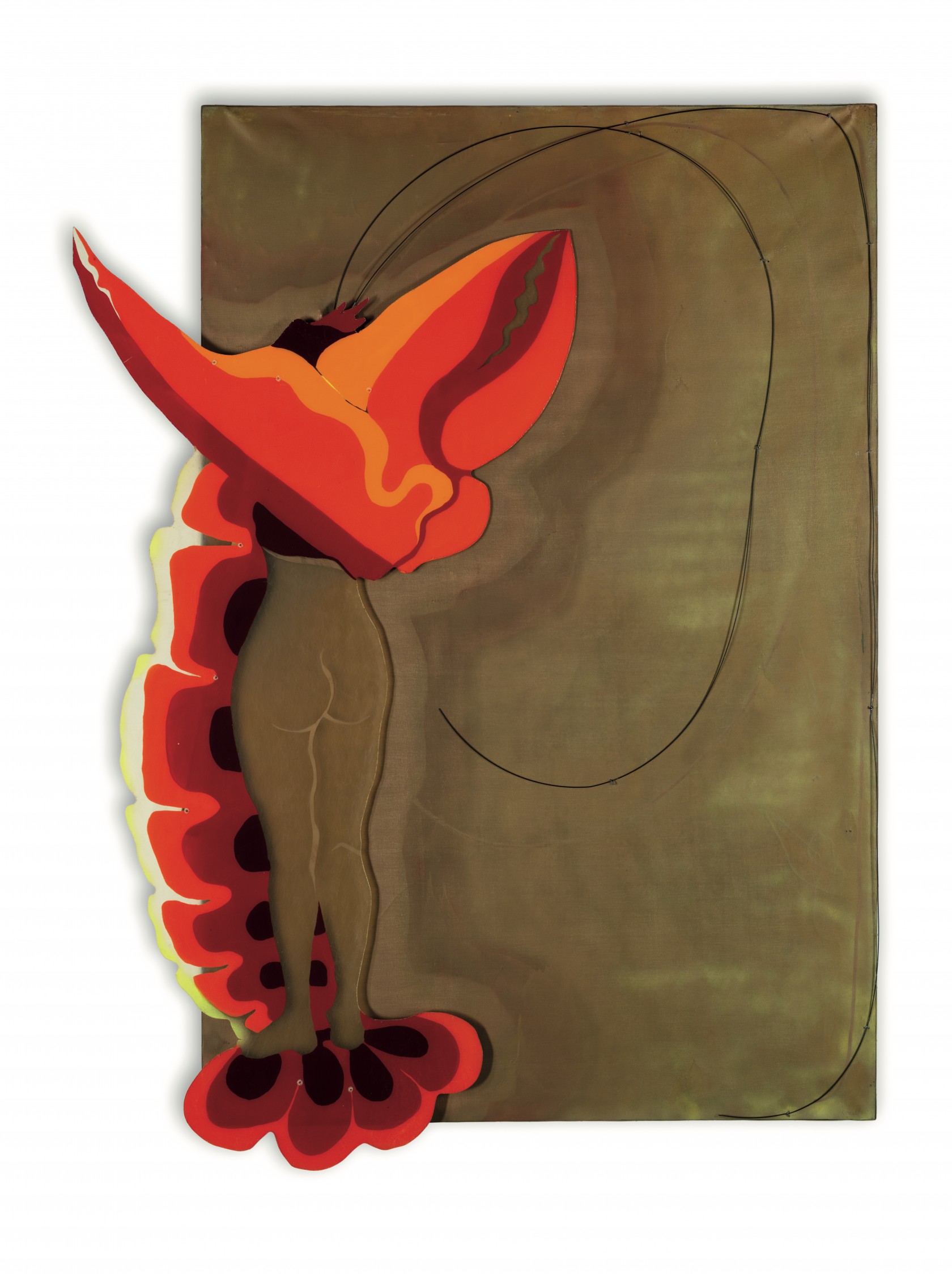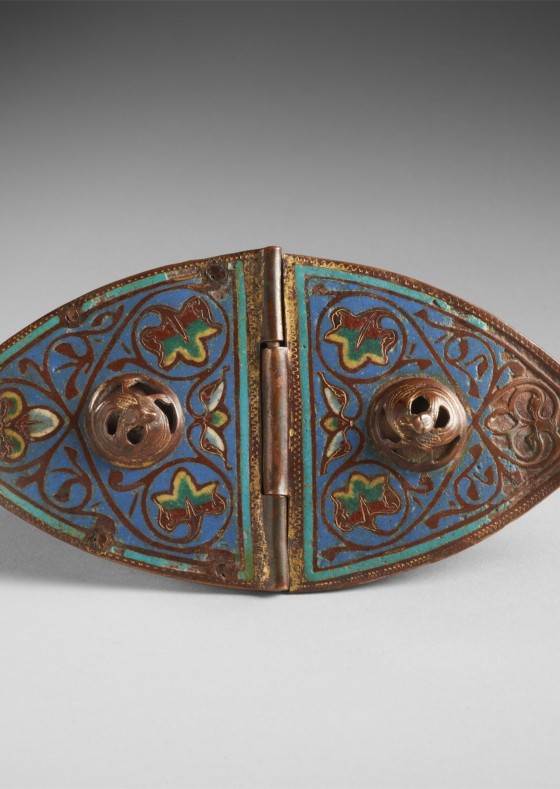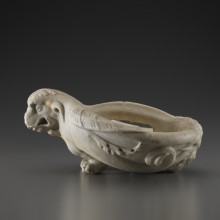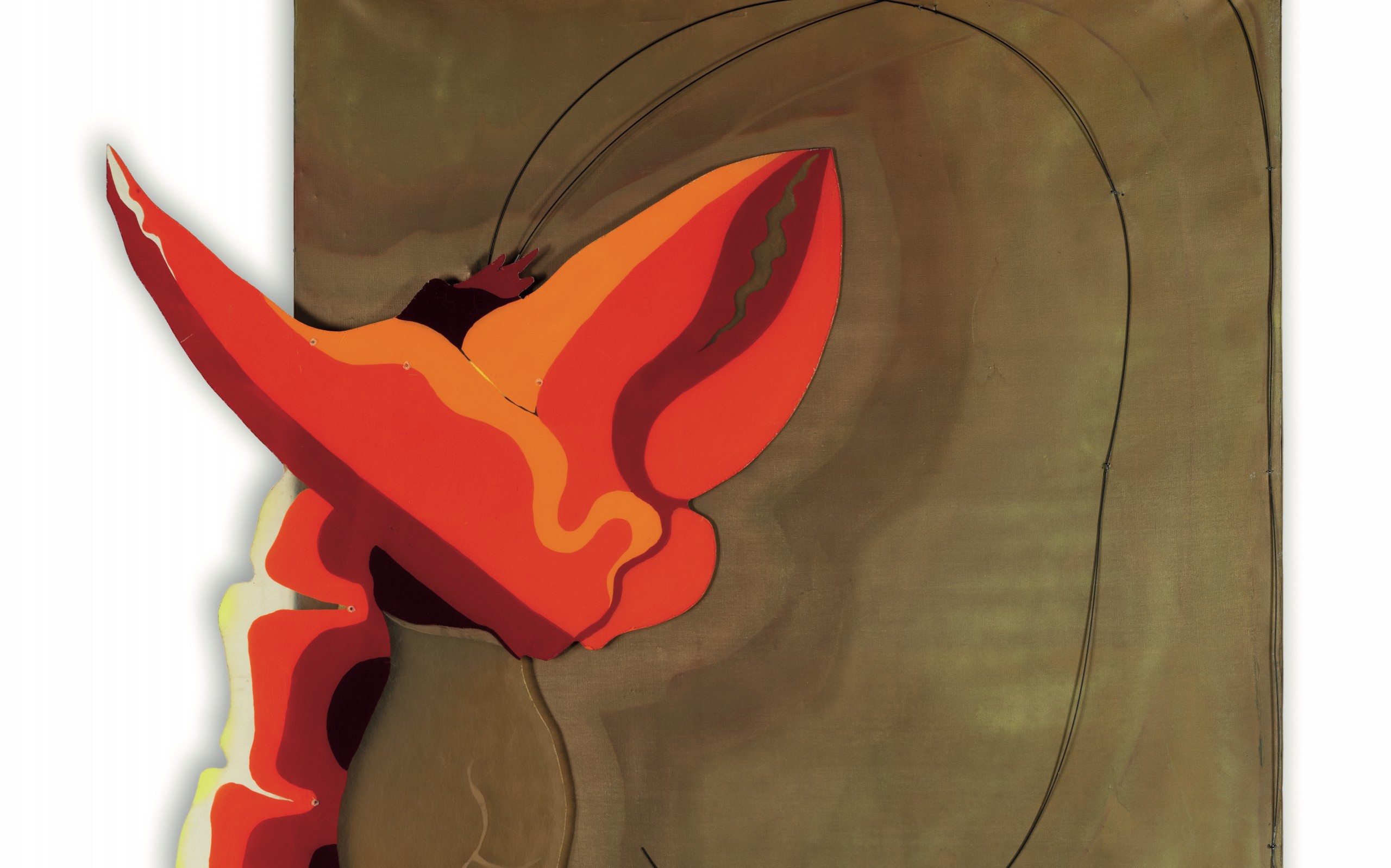
February 2024 Fine Arts
Le Homard amoureux II by Évelyne Axell
Created in 1968, Le Homard amoureux II is a work that brings together the preferred subjects and interests of Évelyne Axell: femininity, eroticism, and the use of new materials. A female figure in Pop Art, she instilled a feminist vision into this movement in Europe within a very short period of time, affirming an emancipated sexuality in her paintings. She sublimated the political and social struggles of her time relating to women’s liberation, playfully mixing bright colours and sensual silhouettes.
See the artwork in the collectionÉvelyne Axell (Namur, 1935 – Zwijnaarde, 1972)
Le Homard amoureux II
1968
Synthetic oil paint, Clartex board, and wire
203.5 x 154.4 x 5.4 cm
FGA-BA-AXELL-0001
Provenance
The artist’s family
Musée d’Ixelles, Brussels, 1986-2006 (long-term loan)
Galerie Antoine Laurentin, Brussels, 2018
Exhibitions
Évelyne Axell, Bruxelles, Palais des Beaux-Arts, 12.05 – 18.06.1978
Évelyne Axell et les années 60, Un frisson de vie, Bruxelles, Musée d'Ixelles, 10.10 – 14.12.1997
Évelyne Axell en de jaren '60. Het ruisen van het leven, Ostende, PMMK, 07.08 – 26.09.1999
Évelyne Axell, 1935-1972. Die belgische Amazon der Pop Art, Berlin, Fernsehturm, 26.01 – 25.02.2006
Évelyne Axell. Du viol d'Ingres au retour de Tarzan, Clermont-Ferrand, Musée d'art Roger-Quilliot, 19.05 – 10.09.2006
The Sixties Seen by Évelyne Axell, Bruxelles, Galerie Patrick Derom, 04.10 – 18.11.2006
The 60s and the 70s in Belgium, Bruxelles, Galerie Antoine Laurentin, 19 – 22.04.2018
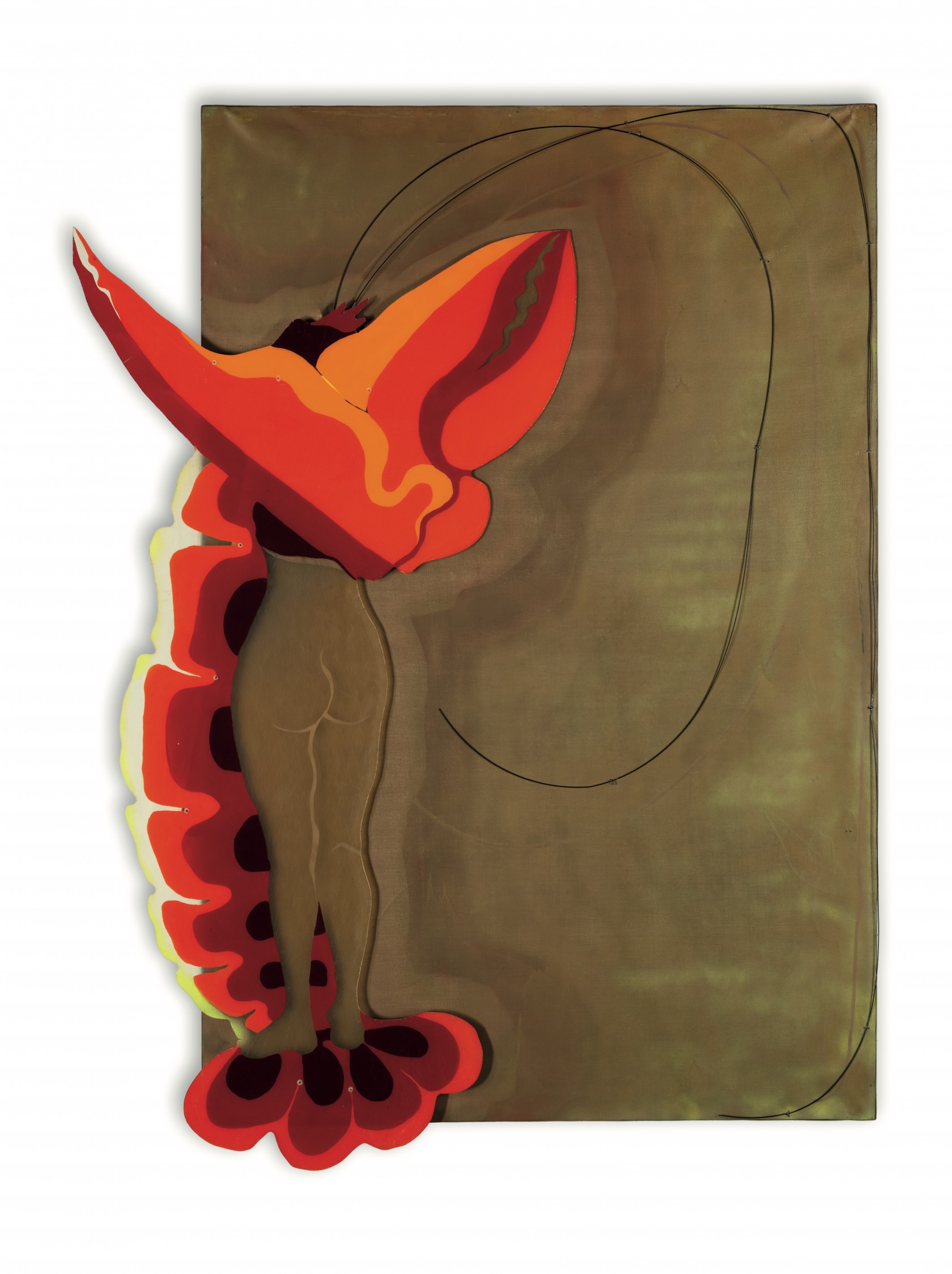
From actress to painter
After a brief career on television, first as an actress1, then as a presenter, she decided to devote herself entirely to painting from 1964 onwards. Self-taught, she found a mentor in René Magritte who gave her some lessons and commented on her work. Évelyne Axell’s oeuvre may be said to be fully in tune with the 1960s, an extremely fertile and innovative period, where part of the young generation adhered to the “Pop” movement. This thrill of life was at the heart of her research, which was also its direct expression: she experimented with new processes specific to her, like working with plastic, Plexiglas, and Formica, in bright, translucent colours, in an attempt to transcribe subjects, close to her heart, such as feminism and sexual emancipation. Her career ended prematurely in 1972, when she died in a fatal car accident at the young age of thirty-seven.
Pop Art in the Flat Country
In Belgium, as in the rest of Europe, while post-war art was dominated by Expressionism and Abstraction, Anglo-Saxon Pop Art breathed new life into the artistic landscape, drawing painters out of their relative lethargy2. Pop Art fascinated the new generation of Belgian artists, who were inspired by this emerging freedom of expression that allowed them to embark on innovative artistic paths. It wasn’t until the opening of the Pop Art, Nouveau Réalisme, etc. exhibition3 at the Palais des Beaux-Arts in Brussels in 1965 that a veritable Pop Art exhibition featuring Belgian artists took place. It presented the work of Pol Mara and Paul van Hoeydonck, alongside the French New Realists and English and American Pop artists4. Opting immediately for a return to the image based on the vocabulary of Pop Art, Évelyne Axell sought modernity through forms, colours, and materials. She began selling her first works to Belgian collectors before being invited to the Palais des Beaux-Arts in Brussels in 1967 for her first solo exhibition5. In 1970, she participated in the exhibition Pop Art, Nouveau Réalisme, Nieuwe Figuratie in Knokke-le-Zoute and the following year, she held her second solo exhibition at the Palais des Beaux-Arts, which would also be her last.
Women, women, women
Évelyne Axell was a feminist artist with a keen sociopolitical consciousness who spoke out against the prejudices suffered by women. The discourse of the Women’s Lib Movement6 radically changed her opinion of the role of women in society in the 1960s. She also became involved with the Belgian support group for Angela Davis7, a commitment obvious in a work titled Joli mois de mai from 19708.
Symbol of an emancipated sexuality, the woman as portrayed by Évelyne Axell was often represented as a pin-up, but served above all to protest against the status and image of women in a society that was still very corseted. She went even further by giving the female nude a significant role, imbued with eroticism and whose curves were a direct reflection of her own image9. “Art for Évelyne Axell [was] not an activity external to oneself, […] [it] [was] a way of living, acting, thinking, and therefore, painting, which [was] not separate from everyday behaviour.”10
Love struggle
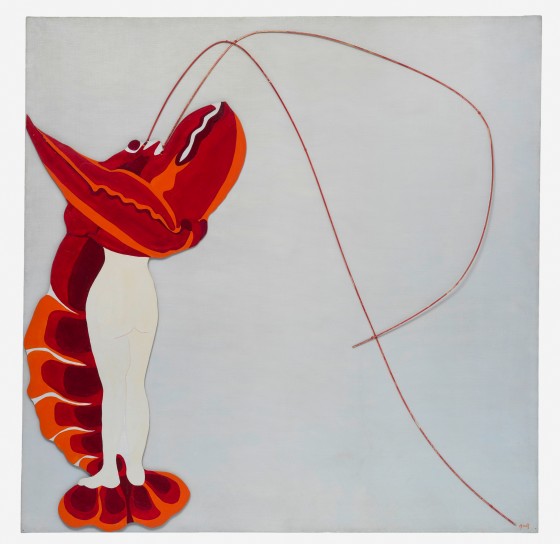
Le Homard amoureux II was produced in 1968, one year after the first version of Homard amoureux (ill. 2). To the left of the work, occupying a large part of the painted surface, a giant lobster embraces a naked female body. The woman is outlined by the contours of a silhouette seen from behind. Only the lower part of her body is visible, from the hips to the feet. The woman’s sensual curves are depicted identically in other works dating from the same year, like Les Gants rouges11 and Cercle vicieux rouge (ill. 3).
This painting is part of a body of work imbued with feminine sensuality at a time when the Women’s Liberation Movement and the sexual revolution were taking place. The notion of struggle is symbolized by the lobster’s devouring embrace. It dominates by its disproportionate size—thus reinforcing the unexpected nature of the embrace—, by its grip, and the flamboyant colours revealing the extent of its passion for the woman. The lobster also stands out for the space it occupies on the entire painted surface: the right section is also invaded by its antennae. They form, in fact, a circular movement that extends to the far right edge of the canvas. Initially, the artist had given the antennae a more meandering trajectory as evidenced by a photograph taken by Évelyne Axell in 1968 on the terrace of her studio (ill. 4). Several marks left by the wire and the staples, materializing the creature’s antennae, are perceptible and demonstrate that the initial sinuous position eventually gave way to a more harmonious movement.
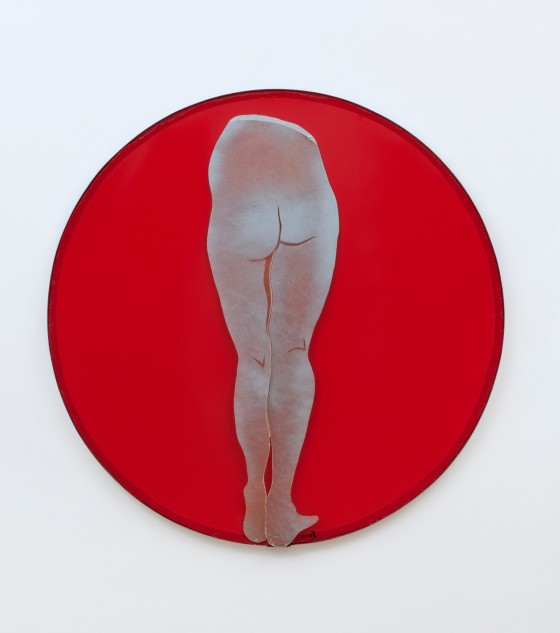

he contrast and duality between the two protagonists are striking. The bright red and orange colours of the lobster radically oppose the coppery and somewhat dull hue of the female body that practically blends into the rest of the canvas. The dominant-dominated power play is equivocal. However, the title of the painting radically reverses this mechanism. It is the lobster that is in love, and not the woman, placing the crustacean in a position of fragility and loss of control in terms of the love relationship. The female figure, although trapped in the lobster’s claws, has the power to say no and move on. Which she will most likely do since to the question: “Who will be the winner in this love struggle?”, Axell once replied: “The woman. Because after love-making, she will eat the lobster”.12
It is the lobster that is in love, and not the woman, placing the crustacean in a position of fragility and loss of control in terms of the love relationship. The female figure, although trapped in the lobster’s claws, has the power to say no and move on.
La Vénus aux plastiques
In the 1960s, while most Belgian artists continued to be marked by Abstraction, Évelyne Axell was one of the first to launch into Figuration. Her use of colour was vivid, her approach to materials, original and experimental. She quickly incorporated plastic, synthetic fur, acrylic paint, and car enamel into her compositions. She became Axell, la Vénus aux plastiques13 with a definite Pop dynamic.
She explored the use of these new materials which offered her numerous technical, artistic, and aesthetic possibilities. Unlike her first version of Homard amoureux, Évelyne Axell decided to represent her lobster on Clartex, a polyester-based resin fiberglass panel, which she discovered in 1967. She could thus experiment with a more sculptural dimension in her work. Firstly, with the transparencies by superimposing the cut-out forms, and then with the flattened volumes by privileging the line rather than the brushstroke style and the impasto technique specific to Abstract artists. By using plastic, which had become easily accessible in stores, she had found a way to stand out from male dominance and to promote a new form of expression. Axell chose to take an innovative path, free from any critical apparatus and outside of traditions14.
Lobster love, female style
With this artwork, Axell extended her exploration of a bestiary of a singular genre, based on the lobster, which started in 1967 with her tondo Cœur pincé and culminated in Le Jour où les homards…, produced the following year15. This temporary “lobster penchant” gave way in the years 1970-1972 to an Edenic vision of nature, with a more classical bestiary featuring monkeys, elephants, and birds16.
However, it is above all women, femininity, and sensuality that remain the focus of Axell’s work. A carnal, even erotic work, resolutely provocative, in resonance with its time: an era that witnessed emancipation from the shackles of thought, and the liberation of morals, bodies, and taboos. Axell was free and courageous working in a sphere dominated by men. She criticized the patriarchy and asserted her femininity and hedonism. In her own way, she fought for the independence of women and still today, her work remains very evocative with its transgressive iconography, feminist undertones, and utopian vision17.
Anne-Valérie Ecoffey
Assistant Curator of the Fine Arts Collection
Fondation Gandur pour l’Art, February 2024
Notes and references
- ANTOINE, Jean, Le crocodile en peluche, Brussels, 1963, 174 mins. Film written by Évelyne Axell, who also played the lead female role, and directed by her husband, Jean Antoine.
- JACOBS, Carl, Pop Art in Belgium! Een/Un coup de foudre, exhibition catalogue [Brussels, ING Art Center, 15.10.2015 – 14.02.2016], Brussels, ING Belgium; Fonds Mercator, 2015, p. 4.
- This is the Belgian version of the exhibition Nieuwe realisten held at the Gemeentemuseum in The Hague in 1964. Nieuwe realisten, exhibition catalogue [The Hague, Gemeentemuseum, 24.06 – 30.08.1964], The Hague, Haags Gemeentemuseum, 1964.
- DE LONGRÉE, Isabelle, The 60s & 70s in Belgium, exhibition catalogue [Brussels, Galerie Laurentin, 13.04 – 17.06.2018], Brussels: Galerie Laurentin, 2018, p. 44.
- JACOBS, Carl, op. cit., p. 52.
- The Women’s Liberation Movement was a movement created in the United States in the 1960s by women protesting against all forms of sexism and the discrimination of which they were the victims, in a plea for equal rights with men.
- On this subject, see also the notice the Work of the Month of the Fondation Gandur pour l’Art by Lucie Pfeiffer, Ivan Messac, Black Panther, Tigre de papier, published in March 2023.
- Mu.Zee Collection in Ostende, inventory number K000521: https://www.muzee.be/nl/collectie-1/joli-mois-de-mai
- DECAN, Liesbeth, Axelleration: Évelyne Axell, 1964-1972. Brussels: Lannoo, 2011, p. 17.
- WILSON, Sarah, et al., Évelyne Axell, From Pop Art to Paradise / Le Pop Art jusqu’au paradis, exhibition catalogue [Namur, Musée Félicien Rops, Maison de la Culture de la Province de Namur and Galerie Détour in Jambes, 08.09 – 24.10.2004], Paris: Somogy éditions d’art, 2004, p. 46.
- ROUX, Nathalie (ed.), Évelyne Axell. Du viol d’Ingres au retour de Tarzan, exhibition catalogue [Clermont-Ferrand, Musée d’Art Roger-Quilliot, 19.05 – 19.09.2006], Roche-La-Molière: I.A.C. éditions, 2006, p. 100.
- CRISPOLTI, Enrico (ed.), Alternative Attuali 3 – Rassegna internazionale d'arte contemporanea, exhibition catalogue [L'Aquila, Castello Spagnolo, 07 – 09.1968], Florence: Centro di / edizioni, 1968, p. 3.183.
- Title of the documentary film by Levie, Françoise, Évelyne Axell, la Vénus aux plastiques, Belgium, 2013, 73 mins.
- KALLIOPI, Minioudaki; DEVILLEZ, Virginie, Pop Impact: Women Artists, exhibition catalogue [Namur, Maison de la Culture de Namur, 17.09.2015 – 24.01.2016], Brussels: Luc Pire, 2015, p. 51.
- WILSON, Sarah, et al., op. cit., p. 85 no. 51 (Cœur pincé, 1967) & p. 99 no. 78 (Le Jour où les homards…, 1968).
- Évelyne Axell’s internet site: https://www.evelyne-axell.info/fra/ (consulted 15 January 2024).
- Évelyne Axell: Body Double, exhibition booklet, [Susch, Muzeum Susch, 01.08.2020 – 22.05.2021], Susch: Museum Susch, 2020.
Bibliography
DECAN, Liesbeth, Axelleration: Évelyne Axell 1964-1972, exhibition catalogue [Mönchengladbach, Museum Abteiberg, 03.07 – 03.10.2011], Brussel: Lannoo; Mönchengladbach, Museum Abteiberg, 2011, listed p. 109, col. repr. p. 48, no. 26.
DE LONGRÉE, Isabelle, The 60s & 70s in Belgium, exhibition catalogue [Brussels, Galerie Laurentin, 13.04 – 17.06.2018], Brussels: Galerie Laurentin, 2018, col. repr. p. [23].
Évelyne Axell: Body Double, exhibition booklet, [Susch, Muzeum Susch, 01.08.2020 – 22.05.2021], Susch, Muzeum Susch, 2020, b/w repr. p. 31, no. 1.
RESTANY, Pierre, Un Frisson de la vie: Évelyne Axell et les années 60, exhibition catalogue [Brussels, Musée d’Ixelles, 10.10 – 14.12.1997], Gand: Snoeck-Ducaju & Zoon, 1997, p. 39.
ROUX, Nathalie (ed.), Évelyne Axell. Du viol d'Ingres au retour de Tarzan, exhibition catalogue [Clermont-Ferrand, Musée d’art Roger-Quilliot, 19.05 – 10.09.2006], Roche-la Molière: I.A.C. éditions, 2006, listed p. 138, col. repr. p. 79, no. 25.
SCHUBERT, Yan (ed.), Années pop, années choc, 1960-1975, exhibition catalogue [Caen, Mémorial de Caen, 22.06 – 31.12.2023], Gand: éditions Snoeck, 2023, col. repr. p. 10, no. 3.
WILSON, Sarah, Évelyne Axell, From Pop Art to Paradise / Le Pop Art jusqu'au paradis, exhibition catalogue [Namur, Musée provincial Félicien Rops, Maison de la culture de la province de Namur, Galerie Détour à Jambes, 09.09 – 24.10.2004], Paris: Somogy Éditions d’Art; Namur, Musée provincial Félicien Rops, 2004, col. repr. p. 98, no. 77.

